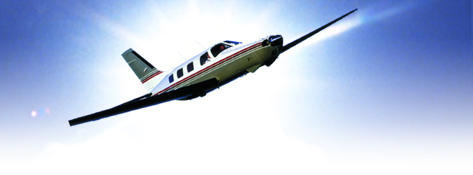My Nicest Experience
by Dr. Michael Offermann
Friday,
Surgery in Essen until 3 pm, lecture in Stuttgart at about 5.45 pm. Does anyone think that could be a problem? I don’t. Not really.
The calculated flying time from EDLE to EDDS is approx. 61 minutes, with a tailwind at FL 250 only 49 minutes.
If it wasn’t for the weather in Essen – the whole day, (very) low hanging clouds with occasional heavy rain. One of those days when it’ll be rather difficult to take off legally in Essen.
So what can a good citizen do other than what he has always done in the last 20 years, namely call up someone in authority, someone who doesn’t split hairs, someone who always helps out, someone who is the Flight Supervisor at Düsseldorf, to ask his advise on a way out of the predicament?
It used to go something like this: Get on the Squak phone, discuss a particular flight procedure, right around to BAM or BOT at 1,500 ft, on the runway - depending on the departure - either 120.05 or 128.55 was called and IFR pick-up before take-off, so to speak.
The problem this time is that the Flight Supervisor’s number seems to have changed – on the way to the airfield there’s repeatedly no connection.
So phoned the switchboard at Düsseldorf International Airport to get the “new” number. She can’t connect due to it being an “external” call.
Dialled again while the traffic light is red and amazingly someone answers immediately. Not only that, but someone who understands my problem – that’s OK, no trouble, but… he’s not the right man to talk to – it’s the number of the Tower at Düsseldorf.
The Flight Supervisor responsible is now located in Langen.
The good news is: This number is available too.
I now phone the third number on the motorway in pouring rain, but this time, having learnt from experience, I enquire whether I really am talking to the Flight Supervisor for southerly take-offs from Düsseldorf, because the problem is such and such.
It is him and he represents, so to speak, the power, the concentrated responsibility and flexibility of the DFS in person.
I need three goes at trying to explain to him what I want from him in the first place. My question, or rather request, apparently belongs to the surreal world of some sort of airborne Stefan Zweig.
Would he understand it correctly? IFR take-off from EDLE?
Out of the question! What? That had always been possible in the past? He’d have to ask, one moment please, says the man on the phone who sounds about 25.
Puts the receiver down onto his desk and apparently turns to a colleague to explain my eccentric request.
As one might expect through a telephone receiver that has been put down onto a desk, I can hear the muffled but interesting suggestion which the “colleague“ makes to the Flight Supervisor of South Düsseldorf: He (that’s me) could put his plane on the back of a truck, drive it to Düsseldorf and take off IFR there. Really useful.
No, it’s just not possible, with the best will in the world he really can’t imagine how it ever could have been.
There were only two possibilities: either fly at 500 ft approx. 5 miles to Düsseldorf into the control zone and then with an SID to Stuttgart or VFR up to Minimum Radar Vectoring Altitude and then IFR pick-up.
Anything else would be illegal, he couldn’t and wouldn’t have anything to do with it and what Straubing and Mr Teegen and his colleagues in Bavaria would do was no concern of his.
Break.
At the fuel station in EDLE there’s one of the local flying school’s TB20’s next to me and the young man doing the tanking while the older one stays put in the right-hand seat doesn’t look as if he’s been flying with ATPL for years.
Quite right in fact: IFR training.
How interesting. Just see what the Flight Supervisor has told them.
And it gets more interesting during the conversation. A good thing that I’ve asked. You can always learn something when you ask the right people: An EDLE Jeppesen Card is produced.
What surprises me is that I hadn’t heard that Jeppesen have now published GPS landing and take-off procedures for one and the same place on one and the same sheet. And why is the VFR in the top right-hand corner??
5.10 pm Landing in Stuttgart, lecture at 5.45 and, like I said, really no problem at all.
But a good thing that visibility increased to 1.5 km a short time after take-off and there were no clouds up to about 2,301 ft.
All you need is a bit of luck when you’re flying IFR.



